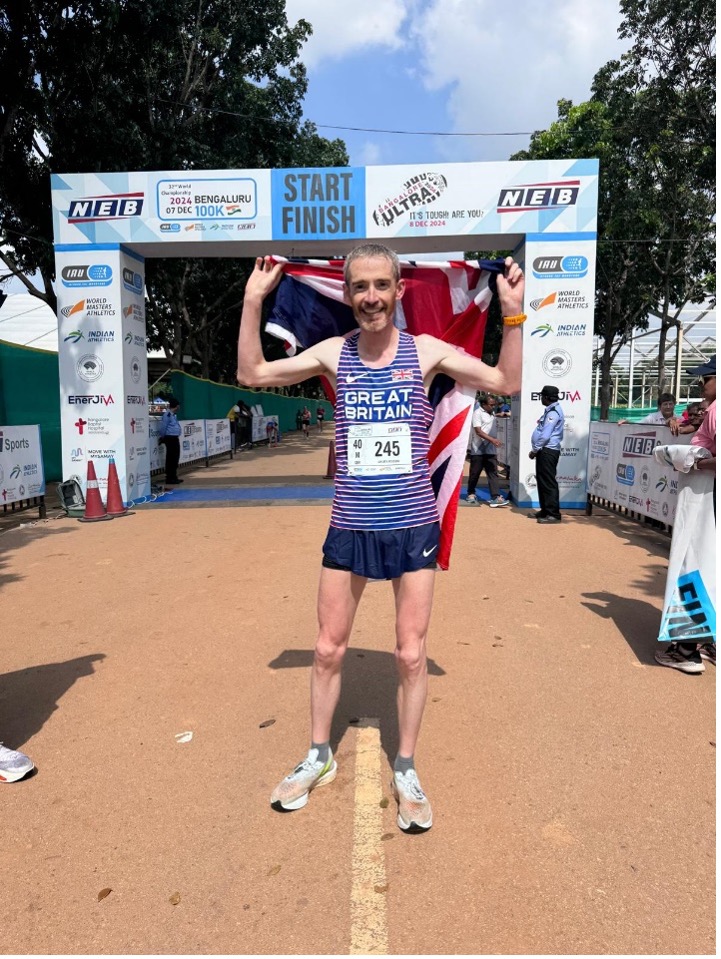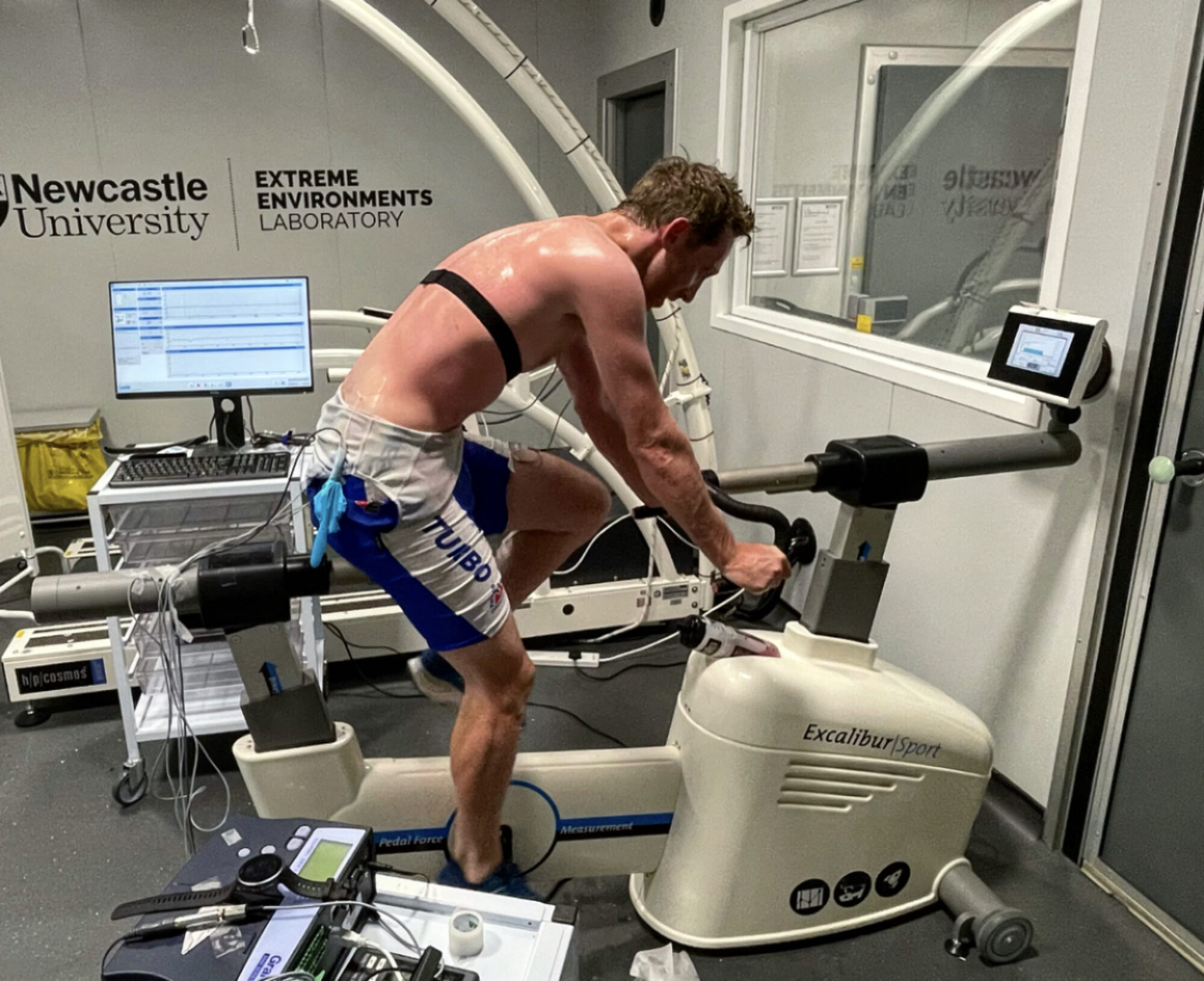Jarlath, recently came in for a chat about how to prepare for the hot conditions in the World Championship 100km running race*. This was held in India in a town named Bengaluru which is at 920 metres in altitude. The combination of altitude and that the race took place in December meant that temperatures were not as extreme as they can be in India, however peak temperatures reached around 27oC which is still a considerable heat stress over a long period of time. In a field of over 250 athletes from 40 countries, Jarlath (GBR) finished 9th overall (in a time of 6:51:20h) and second GBR male, helping the men’s team claim bronze medals. In this question & answer we will ask him how he got on and what strategies he used to help him in the environment.
*2024 IAU (International Association of Ultrarunners) and WMA (World Masters Championships) 100km World Championships in Bengaluru India.

Jarlath pictured during the event wearing his own neck cooling system and dousing himself in water.
So, tell us how did the race go?
Better than I could have dreamed! The experience of going to India with the team was special in itself and I really enjoyed the build-up to the race when I got out there. The race was set to start at 6am local time and already it was feeling warm on the bus on route to the start which was a bit worrying. My plan was to run within myself in the opening laps and depending on how I felt look to push on in the second half. For the first 50km or so, the GBR men’s team ran more-or-less together which really helped in that early part. As the race wore on naturally the distance and conditions started to take its toll and I had to dig deep. I even had a ‘sprint’ finish over the last half mile to hold off a competitor. While my pace did drop, results show that I moved up from 25th at halfway to my 9th place finish. The day was topped off with a nice curry and awards ceremony.

Temperature forecast for Bengaluru on race day – taken from https://weatherspark.com/
We had chatted a month or so before the race and discussed some strategies to prepare for hot environments and how to understand body temperature and adaptation, how did your heat preparation go?
It was challenging but worth it. Out of the approaches we discussed I focussed mainly on passive. I used a hot sauna or a hot bath nearly every day in the 3 week lead into departing for India. The sauna was obviously very hot and I would sit on the top step and tolerate this as long as possible. Usually the first 15 minutes was easy, the second 15 minutes bearable hot and the final 10-15 minutes felt almost intolerable, making a total of 40-45 minutes [Saunas are typically +50-70 oC – exact temp unknown]. On days that I used the bath at home, I ran it as hot as possible and measured this around 42-43 oC using a standard glass thermometer. Again I would try to tolerate this as long as possible but this was typically around 30 minutes [some recent data from our lab indicates that in a constant maintained water temp of 42 oC (a bath will lose heat over time) core body temperature will increase by ~1 oC in around 15-20minutes].

Jarlath at the finish of the race with the union jack.
Was there anything else that you tried?
I did try layering up when running as you suggested [to increase heat storage by reducing convective and evaporative heat loss avenues] and was noticeably warmer, but to be honest I didn’t use this much as I did not want to compromise my run sessions. It is something I might have tested further if I had more time as it does seem effective.
Was monitoring core body temperature useful?
I used the CORE temperature sensor you provided and paired this with a polar heart rate monitor. I found this useful to give me some understanding on how quickly or slowly my body temperature would rise when running and to get a sense of how hot I felt when core body temperature was above 38.5 oC [current understanding is that to optimise thermal stress body core temperature needs to be within the range of 38.5 – 39.5 oC]. It also showed me how quickly I would cool off after stopping activity. However, I didn’t use this for all sessions or during sauna heat training, and in the race I didn’t want the restriction of wearing a heart rate strap. I would say overall it helped me to establish some benchmarks.
How did the temperatures feel during the race?
Surprisingly, I felt fine. I know others did struggle with the heat [the dropout rate was almost 50%] but I didn’t feel like the heat was a major factor in my race. I put this down mainly to the heat preparation work I did. In the past I have been apprehensive of racing in hot conditions, having had a few bad experiences—this has given me a lot of confidence that I can prepare and tolerate the heat better.
What cooling strategies were you able to use in the race?
I had prepared several snoods, stitched to form a pocket that could be packed with ice and then tightened around my neck (akin to an ice bandana). I was able to pick a fresh one up each lap (laps were ~3 mile in length), from the GB support crew, which was a great help in cooling down and improving my tolerance of the heat. I also doused myself in water twice every lap. In anticipation of the conditions, I had deliberately reduced pace to compensate [by about 15 seconds/mile].

GBR men’s team bronze, Jarlath second from left.
Thanks to Jarlath for taking the time to share his experience of heat training on route to an excellent result at the World Championships!
